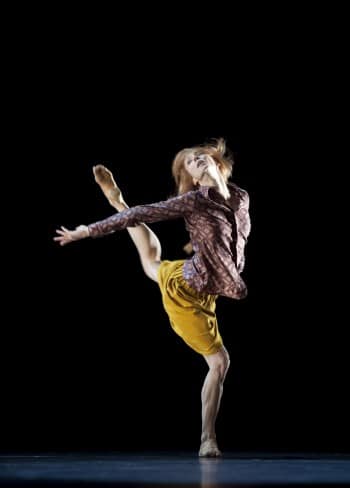Adelaide Festival: 6000 miles away

Finally, a chance to see what all the fuss is about. Sylvie Guillem, prima ballerina assoluta, and the darling of the world’s greatest contemporary choreographers, comes to Adelaide in a triple bill, whose title is a tribute to the victims of the Japanese earthquake and tsunami. She is not alone.
The first piece by Jiri Kylian is danced by Vaclav Kunes and Natasha Novotna, in a series of images which may represent a woman’s journey through life. The male dancer attempts to throw her off balance, strips off her red top and joins her in a series of brief duets, until Death, maybe, arrives and the two dancers are wrapped up in the stage cloth. The piece is entitled 27’32” but certainly takes less than that to perform.
Then the lights go down, and fade in slowly as Guillem appears simply dressed in dark clothes with one of her favoured dance partners, Massimo Murru. The work entitled Rearray by William Forsythe is a series of brief interludes, each terminated by a black out. Only one of these is a solo for Guillem, a lyrical expression of her immense stillness, and her retention of so much of the vocabulary of classical ballet, expressed in her perfect balance and exquisite extensions. So brief are the incidents and so gloomy the stage, that ‘lighting’ is hardly the word to describe it, you wonder what she’s trying to hide? Age? Infirmity? She is after all in her late forties and dancers years are more demanding than ours.
What she’s done is set us up for Bye – The English title suggests a farewell.
This too is a duet. Her partner, though, is Ludwig van Beethoven. The second and final movement of his last piano sonata, the Opus 111 is played by Ivo Pogorelich. While the work, a brief melody and a series of variations can be seen as Beethoven’s farewell to a musical form he basically created, here it gives Guillem and her choreographer Mats Ek the perfect partner for a story about memory and the dance and the realisation that age may constrain the body but not the soul.
Dressed in a skirt which sometimes constricts her amazing leg extensions and a cardigan that hangs on those strong shoulders, she becomes an older woman, maybe herself in a few years time, dancing, reminiscing, fantasising. The theme and variation form allows repeated movements and returns; one especially affecting is a gesture in which she knocks at a door barely waiting for a reply.
The whimsical nature is reinforced by some remarkable technical assistance from Katrin Brannstrom and Erik Berglund. On the empty stage as the work begins we see a door. Then a projection of Guillem’s face as she peers, larger than life, as if into a doll’s house. She appears on the screen life size and then, magically and with immense humour, as the projected figure rises, her real head appears above the door.
Throughout the work she plays with the image and reality, depending on one of her great gifts as a dancer, an infallible inner sense of rhythm and elapsed time.
She ignores the gentleman caller, and the dog. Finally she reenters the illusory world to join a community who have gathered at that door.
The work is mischievous, loving, impeccably created and distils all the gifts of her younger career into something mature and yet full of fun.

